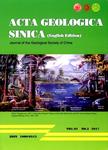Genesis of the Bangbu Orogenic Gold Deposit, Tibet: Evidence from Fluid Inclusion, Stable Isotopes, and Ar-Ar Geochronology
Genesis of the Bangbu Orogenic Gold Deposit, Tibet: Evidence from Fluid Inclusion, Stable Isotopes, and Ar-Ar Geochronology作者机构:School of Earth Sciences and Resources China University of Geosciences Beijing 100083 China Institute of Mineral Resources Chinese Academy of Geological Sciences Beijing 100037 China Geological Survey of Jiangsu Province Nanjing 210018 China
出 版 物:《Acta Geologica Sinica(English Edition)》 (地质学报(英文版))
年 卷 期:2016年第90卷第2期
页 面:722-737页
核心收录:
学科分类:070902[理学-地球化学] 0709[理学-地质学] 0819[工学-矿业工程] 081803[工学-地质工程] 07[理学] 08[工学] 0818[工学-地质资源与地质工程] 0708[理学-地球物理学] 0816[工学-测绘科学与技术]
基 金:funded by the National Basic Research Program of China(No.2011CB403104) Geological Survey Project of China(No.12120113037901)
主 题:fluid inclusions stable isotope Ar-Ar dating Bangbu deposit orogenic gold deposit Tibet-Himalayan orogen southern Tibet
摘 要:The Bangbu gold deposit is a large orogenic gold deposit in Tibet formed during the AlpineHimalayan collision. Ore bodies(auriferous quartz veins) are controlled by the E-W-trending Qusong-Cuogu-Zhemulang brittle-ductile shear zone. Quartz veins at the deposit can be divided into three types: pre-metallogenic hook-like quartz veins, metallogenic auriferous quartz veins, and postmetallogenic N-S quartz veins. Four stages of mineralization in the auriferous quartz veins have been identified:(1) Stage S1 quartz+coarse-grained sulfides,(2) Stage S2 gold+fine-grained sulfides,(3) Stage S3 quartz+carbonates, and(4) Stage S4 quartz+ greigite. Fluid inclusions indicate the oreforming fluid was CO_2-N_2-CH_4 rich with homogenization temperatures of 170–261°C, salinities 4.34–7.45 wt% Na Cl equivalent. δ^(18)Ofluid(3.98‰–7.18‰) and low δDV-SMOW(-90‰ to-44‰) for auriferous quartz veins suggest ore-forming fluids were mainly metamorphic in origin, with some addition of organic matter. Quartz vein pyrite has δ^(34)SV-CDT values of 1.2‰–3.6‰(an average of 2.2‰), whereas pyrite from phyllite has δ^(34)SV-CDT 5.7‰–9.9‰(an average of 7.4‰). Quartz vein pyrites yield 206Pb/204 Pb ratios of 18.662–18.764, 207Pb/204 Pb 15.650–15.683, and ^(208)Pb/204 Pb 38.901–39.079. These isotopic data indicate Bangbu ore-forming materials were probably derived from the Langjiexue accretionary wedge. 40Ar/39 Ar ages for sericite from auriferous sulfide-quartz veins yield a plateau age of 49.52 ± 0.52 Ma, an isochron age of 50.3 ± 0.31 Ma, suggesting that auriferous veins were formed during the main collisional period of the Tibet-Himalayan orogen(-65–41 Ma).



